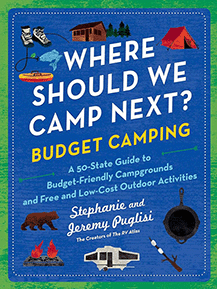This week on The RV Atlas podcast, we cover three topics that have recently been asked about in our private Facebook group: exploring Northern California with your RV, practical tips for RVing with teenagers, and advice on how to store and protect your RV during the winter months. Whether you’re planning a summer road trip, navigating the complexities of camping with teens, or preparing your rig for off-season storage–or doing all three at the same time–this podcast is packed with helpful insights from our own experience and advice from the larger RV Atlas community.
To listen–click on the media player above or subscribe to the RV Atlas wherever you get your favorite shows!
RVing in Northern California: Don’t Sleep on the Trip Planning for this Destination

Northern California is a dream destination for many RVers, offering stunning natural beauty and unique attractions. When planning a trip to this region, the Redwoods National and State Parks should be at the top of your list. This combined system of parks is home to some of the oldest and largest trees on Earth and offers incredible hiking, wildlife viewing, and awe-inspiring landscapes.
Side Note: We have a whole chapter dedicated to this region in Where Should We Camp Next?: National Parks, so check it out for more detailed recommendations. We also have podcast episodes about the Redwoods–click here to listen.
Recommended Campgrounds
- Redwoods KOA in Crescent City: This campground features both old-growth forest sites and standard KOA amenities. It’s a practical choice for RVers with larger rigs who want a mix of natural beauty and comfort.
- Jedediah Smith Campground: Located right in the heart of the redwoods, this campground is perfect for smaller RVs and offers a more rustic, immersive experience.
- Gold Bluffs Beach Campground: Nestled along the coast, this site offers unforgettable ocean views. However, access is limited to smaller RVs or motorized units due to the challenging road conditions.
Planning Tips
When traveling with kids or teenagers, balance is key. Nature lovers will marvel at the grandeur of the redwoods, but after a few hikes, variety is essential to keep everyone engaged. Combine your visit with urban stops like San Francisco, where activities like attending a baseball game or exploring the city’s history can cater to a wide range of interests.
For adventure-seekers, activities like ATV riding, big-wave surfing observation, or ranger-led educational programs can create memorable experiences. We also suggest leveraging “set-jetting” opportunities—like visiting filming locations from Return of the Jedi—to connect kids with the destination in a fun and engaging way.
Tips for RVing with Teenagers: How to Keep Everyone Happy

RVing with teenagers comes with unique challenges and rewards. Their busy schedules and evolving interests can make trip planning more complicated, but a few strategies can help you navigate this phase of family travel.
Practical Tips for RVing with Teenagers
- Adapt Your Itinerary: Teenagers often have packed schedules with sports, band, or other commitments. Look for quiet times in their calendar, such as the first week after school ends or brief gaps between seasons. Use these windows for shorter but meaningful trips.
- Break Up the Family Unit for Some Trips: If older teens are unavailable, don’t hesitate to take younger siblings or friends on trips. This ensures no one misses out on adventures due to scheduling conflicts.
- Let Them Bring Friends: Allowing teenagers to invite friends can make trips more appealing and help them stay engaged. Setting up tents alongside the RV is a practical way to accommodate larger groups.
- Offer Variety: Instead of back-to-back hikes, mix in activities like bike rentals, water-based adventures, or unique tours. For example, renting e-bikes in Zion was a game-changer for our kids.
- Involve Teens in Planning: Ask for their input on destinations and activities. Giving them a say can increase their excitement and buy-in for the trip.
Remember, this phase of family life is fleeting. Keeping flexibility and humor is key to survival when RVing with teenagers.
Should You Cover Your RV During Winter Storage?

Proper winter storage is essential to protect your RV from harsh weather and extend its lifespan. While covering your RV can offer many benefits, there are important considerations to keep in mind.
Covering Benefits and Tips
- Protect from Weather Damage: Covers shield your RV from snow, ice, and UV rays, helping prevent fading and damage to the roof and seals.
- Choose a High-Quality Cover: Invest in a breathable cover with reinforced zippers for door access. This helps prevent moisture buildup that can lead to mold and mildew. Avoid using tarps, which can trap moisture and cause damage.
- Inspect Regularly: If your RV is stored far from home, plan periodic visits to ensure the cover is secure and no water has seeped underneath.
Alternatives to Covering
If you plan to use your RV periodically during the winter—for camping or as a guest house—it might be more practical to skip the cover. However, be aware that this exposes your rig to the elements, which can accelerate wear and tear on exposed areas like the front cap. We personally use our RV extensively throughout the winter, so we don’t cover it. And the additional wear and tear is definitely worth the trade off for our family.
For large RVs, covering can be labor-intensive and requires proper storage for the cover when not in use. Weigh the effort and costs against the benefits to decide what works best for your situation.
Join the Conversation! Have more tips for RVing in Northern California, RVing with teenagers, or storing your rig? Share your thoughts in The RV Atlas Facebook group! Don’t forget to tune in to the full podcast episode for more in-depth advice and insights from our discussions.








